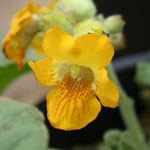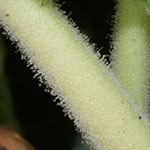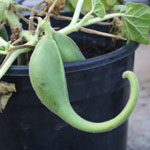Devil's claw (yellow flower)
Common name:
- Devil's claw (yellow flower)
Scientific name:
- Proboscidea lutea (Lindl.) Stapf
Other scientific name:
- Ibicella lutea (indl.) V. Eseltine
Plant status
Catchment management authority boundaries
Regionally prohibited in the Port Phillip and Western Port catchments.
Regionally controlled in the Glenelg Hopkins, Goulburn Broken and North East catchments.
Restricted in the Mallee, Wimmera, East Gippsland, North Central, Corangamite and West Gippsland catchments.
Plant biology
Appearance
Herbaceous plant — Forb (flowering herbaceous plant — not a grass)
Description
Devil's claw (yellow flower) is an erect, low-growing annual herb with an unpleasant odour.
Stems
Stems have many branches and are hollow. They are covered with glandular hairs which exude a slimy, sticky sap.
Leaves
Leaves of Devil's claw (yellow flower) are round to heart-shaped, 5 to 25cm across, opposite and covered with glandular hairs as on the stems. Stalks grow to 20cm long.
Flowers
Devil's claw (yellow flower) has yellow flowers with red or purple markings. They are trumpet-shaped, 2.5 to 5cm long and 5 to 7.5cm in diameter.
Fruit
The fruit of devil's claw (yellow flower) is a bulbous capsule containing numerous seeds, armed with a long curved beak which splits as the fruit matures to form two hard curved claws.
The mature fruit is 10 to 25cm long, generally light brown and with short spines at the base, which are apparent when the outer husk is peeled off.
The claws are longer than the body of the capsule.
Growth and lifecycle
Method of reproduction and dispersal
Devil's claw (yellow-flower) reproduces by seed and is dispersed only by the movement of seeds, usually while still within the fruit.
With its hooked claws, the fruit readily attaches to almost anything which it has contact with, and is likely to spread over distances of 200m.
Seedbank propagule persistence
The weed has a bulbous capsule containing numerous seeds. Each plant bears 10 flowers which contain 100 seeds per capsule, resulting in 1000 seeds per plant.
Devil's claw (yellow flower) is an annual and only produces propagules once a year.
Preferred habitat
Devil's claw (yellow flower) prefers subhumid to humid, temperate to tropical regions mainly on highly fertile soils.
It occurs as an isolated plant and can be found in small patches on roadsides, river flats, neglected areas, and occasionally on cultivated fallows and in annual pastures.
Devil's claw (yellow flower) is tolerant of drought and waterlogged soils.
Distribution
Broad area infestations of Devil's claw (yellow flower) are rare.
Growth calendar
The icons on the following table represent the times of year for flowering, seeding, germination, the dormancy period of Devil's claw (yellow flower) and also the optimum time for treatment.
| Jan | Feb | Mar | Apr | May | Jun | Jul | Aug | Sep | Oct | Nov | Dec | |
|---|---|---|---|---|---|---|---|---|---|---|---|---|
| Flowering | ||||||||||||
| Seeding | ||||||||||||
| Germination | ||||||||||||
| Dormancy | ||||||||||||
| Treatment |
Impact
Impact on ecosystems and waterways
Devil's claw (yellow flower) does not produce dense infestations.
Small patches of isolated devil's claw have the potential to compete with and replace more desirable species. There is a marked seasonal variation in the weed's population size and density.
Agricultural and economic impacts
Devil's claw (yellow flower) is known to compete strongly with summer crops. Presence of the plant has minimal impact on yield.
Its fruit can injure stock when lodged in the mouth, potentially leading to death by starvation. It can also cause physical damage when the claws work into the animal's body or become attached to the feet.
This weed can also cause possible damage to sheep carcasses with the potential for major impact on the quality of the meat.
The dried fruit pods can break the combs of shearing machines delaying clip production and increasing material costs.
Social value and health impacts
Devil's claw exudes slimy, sticky sap through its stems and the unpleasant odour produced by the secretions on the leaves would make it unpleasant to walk through an infestation. The weed poses no toxic properties to humans.
Management
Prescribed measures for the control of noxious weeds:
- application of a registered herbicide
- physical removal.
Read about prescribed measures for the control of noxious weeds.
Other management techniques
Changes in land use practices and spread prevention may also support Devil's claw (yellow flower) management after implementing the prescribed measures.